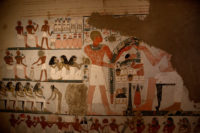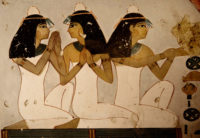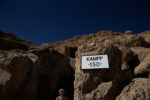 Luxor’s Draa Abul Nagaa necropolis has capped a year of sensational finds with another compelling rarity: two unexplored tombs discovered in the 1990s but never opened or excavated. They were first unearthed by German Egyptologist Friederike Kampp-Seyfried who recorded their existence and named tem Kampp 150 and Kampp 161, but he did not explore them. He excavated Kampp 150 only up to the entrance, and he didn’t get to Kampp 161 at all. They were forgotten and neglected and only rediscovered by Egyptian archaeologists who have been exploring the necropolis
Luxor’s Draa Abul Nagaa necropolis has capped a year of sensational finds with another compelling rarity: two unexplored tombs discovered in the 1990s but never opened or excavated. They were first unearthed by German Egyptologist Friederike Kampp-Seyfried who recorded their existence and named tem Kampp 150 and Kampp 161, but he did not explore them. He excavated Kampp 150 only up to the entrance, and he didn’t get to Kampp 161 at all. They were forgotten and neglected and only rediscovered by Egyptian archaeologists who have been exploring the necropolis
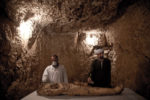 In less than 10 months, archaeologists excavating the necropolis have found more than a thousand ushabti figurines, eight mummies, 10 wooden sarcophagi with still-vibrant polychrome paint, all in the tomb a magistrate named Userhat, the first funerary garden ever discovered and the tomb of a New Kingdom goldsmith named Amenemhat. All of the tombs unearthed this remarkable year date to the 18th Dynasty of the New Kingdom (1550-1292 B.C.) when Luxor, then Thebes, was the capital and the primary religious and administrative center of the kingdom. The people buried at Draa Abul Nagaa originally were likely priests, courtiers and government functionaries.
In less than 10 months, archaeologists excavating the necropolis have found more than a thousand ushabti figurines, eight mummies, 10 wooden sarcophagi with still-vibrant polychrome paint, all in the tomb a magistrate named Userhat, the first funerary garden ever discovered and the tomb of a New Kingdom goldsmith named Amenemhat. All of the tombs unearthed this remarkable year date to the 18th Dynasty of the New Kingdom (1550-1292 B.C.) when Luxor, then Thebes, was the capital and the primary religious and administrative center of the kingdom. The people buried at Draa Abul Nagaa originally were likely priests, courtiers and government functionaries.
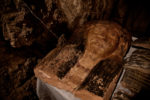 Neither of the newly-opened tombs include inscriptions specifically identifying the deceased as such, so we can’t be certain who was buried there or what function they may have performed at the pharaonic courts. The earlier tomb, Kampp 150, a mud-brick and masonry structure, is about 3,500 years old. It is larger than Kampp 161, with five entrances that open onto a courtyard that has two shaft burials on the north and south side.
Neither of the newly-opened tombs include inscriptions specifically identifying the deceased as such, so we can’t be certain who was buried there or what function they may have performed at the pharaonic courts. The earlier tomb, Kampp 150, a mud-brick and masonry structure, is about 3,500 years old. It is larger than Kampp 161, with five entrances that open onto a courtyard that has two shaft burials on the north and south side.
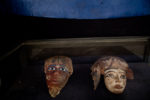 Archaeologists found a significant number of artifacts inside, including painted wood funerary masks, funerary cones, earthenware vessels and around 450 painted wood figurines. They also found human remains: a mummy with intact linen wrappings indicating he was an individual of rank and ministerial importance. On the ceiling is a cartouche of the pharaoh Thutmose I, which dates the tomb and
Archaeologists found a significant number of artifacts inside, including painted wood funerary masks, funerary cones, earthenware vessels and around 450 painted wood figurines. They also found human remains: a mummy with intact linen wrappings indicating he was an individual of rank and ministerial importance. On the ceiling is a cartouche of the pharaoh Thutmose I, which dates the tomb and 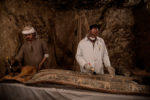 indicates the deceased may have been an official in his government. We do have one potential clue to the occupants of the tomb. Funerary seals in the courtyard bear the names of Maati and Mohi, a scribe and his wife. It’s not as precise as an inscription or dedication, but the presence of multiple seals naming the same couple does suggest they might have been buried there.
indicates the deceased may have been an official in his government. We do have one potential clue to the occupants of the tomb. Funerary seals in the courtyard bear the names of Maati and Mohi, a scribe and his wife. It’s not as precise as an inscription or dedication, but the presence of multiple seals naming the same couple does suggest they might have been buried there.
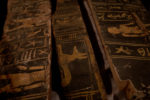 Kampp 161 has a single shaft burial but no remains were found there. There is no tell-tale cartouche to date it, but stylistically the tomb is comparable to its neighbors built in the reigns of Amenhotep II or Thutmose IV, around 3,400 years ago. The crown jewel of the tomb’s decoration is a mural on the western wall that has had some paint loss but not much. What’s left is a richly colored banquet or ritual during which people present offerings to the deceased and his wife. Archaeologists unearthed wooden funerary masks, intact and fragmentary, pieces of wooden furniture, and a painted coffin in the tomb.
Kampp 161 has a single shaft burial but no remains were found there. There is no tell-tale cartouche to date it, but stylistically the tomb is comparable to its neighbors built in the reigns of Amenhotep II or Thutmose IV, around 3,400 years ago. The crown jewel of the tomb’s decoration is a mural on the western wall that has had some paint loss but not much. What’s left is a richly colored banquet or ritual during which people present offerings to the deceased and his wife. Archaeologists unearthed wooden funerary masks, intact and fragmentary, pieces of wooden furniture, and a painted coffin in the tomb.
